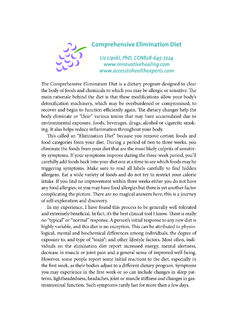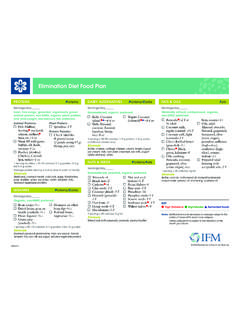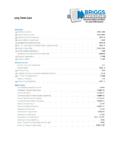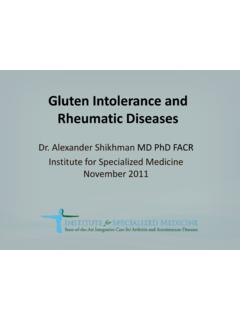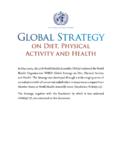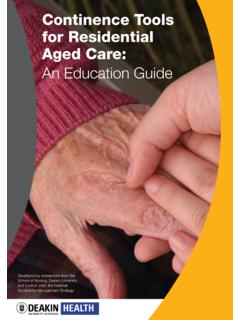Transcription of EATING
1 AED REPORT 2016 | 3RD EDITION. EATING . DISORDERS. A GUIDE TO. MEDICAL CARE. Critical Points for Early Recognition & Medical Risk Management in the Care of Individuals with EATING Disorders DISCLAIMER: This document, created by the Academy for EATING Dis- orders' Medical Care Standards Committee, is intended as a resource to promote recognition and prevention of medical morbidity and mortality associated with EATING disorders. It is not a comprehensive clinical guide. Every attempt was made to provide information based on the best available research and current best practices. For further resources, practice guidelines and bibliography visit: and MEMBERS OF THE AED MEDICAL CARE STANDARDS COMMITTEE: Ovidio Bermudez, MD, FAED. Michael Devlin, MD, FAED. Suzanne Dooley-Hash, MD. Angela Guarda, MD. Debra K. Katzman, MD, FAED. Sloane Madden, MD, PhD, FAED. Beth Hartman McGilley, PhD, FAED, CEDS. Deborah Michel, PhD, CEDS.
2 Ellen S. Rome, MD, MPH. Michael Spaulding-Barclay, MD. Edward P. Tyson, MD. Mark Warren, MD, MPH, FAED. Therese Waterhous, PhD, RDN, CEDRD. Cover Image Copyright: AED REPORT 2016 | 3RD EDITION. EATING DISORDERS: A GUIDE TO MEDICAL CARE. TABLE OF CONTENTS. Key Guidelines 4. EATING Disorders 4. Important Facts about EATING Disorders 5. Presenting Signs and Symptoms 6. Early Recognition 7. A Comprehensive Assessment 9. Criteria for Hospitalization for Acute Medical Stabilization 11. Refeeding Syndrome 12. Information for Medical Specialty Providers 15. Timely Interventions 18. Goals of Treatment 19. Ongoing Management 20. Appendix 1 20. References 23. About the Academy for EATING Disorders 23. KEY GUIDELINES. All EATING disorders (EDs) are serious mental illnesses with significant, life-threatening medical and psychiatric morbidity and mortality, regardless of an individual's weight. Patients with EDs have the highest mortality rates of any psychiatric disorder.
3 The risk of premature death is 6-12 times higher in women with Anorexia Nervosa (AN) as compared to the general popula- tion, adjusting for age. Early recognition and timely intervention, based on a developmentally appro- priate, evidence-based, multidisciplinary team approach (medical, psycholog- ical & nutritional) is the ideal standard of care, whenever possible. Members of the multidisciplinary team may vary and will depend upon the needs of the patient and the availability of these team members in the patient's commu- nity. In communities where resources are lacking, clinicians, therapists, and dietitians are encouraged to consult with the Academy for EATING Disorders (AED) and/or ED experts in their respective fields of practice. EATING DISORDERS. For the purpose of this document, we will focus on the most common EDs including: 1. Anorexia nervosa (AN): Restriction of energy intake relative to an individu- al's requirements, leading to a significantly low body weight in the context of age, sex, developmental trajectory and health status.
4 Disturbance of body image, an intense fear of gaining weight, lack of recognition of the seriousness of the illness and/or behaviors that interfere with weight gain are also present. 2. Bulimia Nervosa (BN): Binge EATING ( EATING a large amount of food in a relatively short period of time with a concomitant sense of loss of control). with purging/compensatory behavior ( self-induced vomiting, laxative or diuretic abuse, insulin misuse, excessive exercise, diet pills) once a week or more for at least 3 months. Disturbance of body image, an intense fear of gaining weight and lack of recognition of the seriousness of the illness may also be present. 4 AED REPORT 2016 | 3RD EDITION. 3. Binge EATING Disorder (BED): Binge EATING , in the absence of compensa- tory behavior, once a week for at least 3 months. Binge EATING episodes are associated with EATING : rapidly, when not hungry, until extreme full- ness, and/or associated with depression, shame or guilt.
5 4. Other Specified Feeding and EATING Disorder (OSFED): An ED that does not meet full criteria for one of the above categories, but has specific dis- ordered EATING behaviors such as restricting intake, purging and/or binge EATING as key features. 5. Unspecified Feeding or EATING Disorder (UFED): ED behaviors are present, but they are not specified by the care provider. 6. Avoidant/Restrictive Food Intake Disorder (ARFID): Significant weight loss, nutritional deficiency, dependence on nutritional supplement or marked interference with psychosocial functioning due to caloric and/or nutrient restriction, but without weight or shape concerns. Consult , DSM-5 or ICD-10 for full diagnostic descriptions. IMPORTANT FACTS ABOUT EATING DISORDERS. ALL EDs are serious disorders with life-threatening physical and psycho- logical complications. EDs do not discriminate. They can affect individuals of all ages, genders, ethnicities, socioeconomic backgrounds, and with a variety of body shapes, weights and sizes.
6 Weight is not the only clinical marker of an ED. People who are at low, normal or high weights can have an ED and individuals at any weight may be malnourished and/or engaging in unhealthy weight control practices. Individuals with an ED may not recognize the seriousness of their illness and/or may be ambivalent about changing their EATING or other behaviors. All instances of precipitous weight loss or gain in otherwise healthy indi- viduals should be investigated for the possibility of an ED as rapid weight fluctuations can be a potential marker of an ED. In children and adolescents, failure to gain expected weight or height, and/or delayed or interrupted pubertal development, should be investi- gated for the possibility of an ED. EATING DISORDERS: A GUIDE TO MEDICAL CARE 5. All EDs can be associated with serious medical complications affecting every organ system of the body. The medical consequences of EDs can go unrecognized, even by an experienced clinician.
7 PRESENTING SIGNS AND SYMPTOMS. Individuals with EDs may present in a variety of ways. In addition to the cog- nitive and behavioral signs that characterize EDs, the following physical signs and symptoms can occur in patients with an ED as a consequence of restrict- ing food or fluid intake, nutritional deficiencies, binge- EATING , and inappro- priate compensatory behaviors, such as purging. However, it is important to remember that a life-threatening ED may occur without obvious physical signs or symptoms. GENERAL: CARDIORESPIRATORY: Marked weight loss, gain, fluctu- Chest pain ations or unexplained change in Heart palpitations growth curve or BMI percentiles Orthostatic tachycardia/hypo- in a child or adolescent who is tension (low blood pressure). still growing and developing Dyspnea (shortness of breath). Cold intolerance Edema (swelling). Weakness Fatigue or lethargy GASTROINTESTINAL: Presyncope (dizziness) Epigastric discomfort Syncope (fainting) Abdominal bloating Hot flashes, sweating episodes Early satiety (fullness).
8 Gastroesophageal reflux ORAL AND DENTAL: (heartburn). Oral trauma/lacerations Hematemesis (blood in vomit). Perimyolysis (dental erosion on Hemorrhoids and rectal prolapse posterior tooth surfaces) and dental caries (cavities) Constipation Parotid gland enlargement 6 AED REPORT 2016 | 3RD EDITION. ENDOCRINE Self-harm Amenorrhea or oligomenorrhea Suicidal thoughts, plans (absent or irregular menses) or attempts Loss of libido Seizures Stress fractures due to low bone DERMATOLOGIC. mineral density/osteoporosis Lanugo hair Infertility Hair loss NEUROPSYCHIATRIC Carotenoderma (yellowish Depressive/Anxious/ discoloration of skin). Obsessive/Compulsive Russell's sign (Calluses or scars symptoms and behaviors on the back of the hand). Memory loss Poor wound healing Poor concentration Dry brittle hair and nails Insomnia EARLY RECOGNITION. Consider evaluating an individual for an ED who presents with any of the following: Precipitous weight changes (significant weight lost or gained).
9 Or fluctuations Sudden changes in EATING behaviors (new vegetarianism/veganism, gluten-free, lactose free, elimination of certain foods or food groups, EATING only healthy foods, uncontrolled binge EATING ). Sudden changes in exercise patterns, excessive exercise or involvement in extreme physical training Body image disturbance, the desire to lose weight despite low or nor- mative weight, or extreme dieting behavior regardless of weight Abdominal complaints in the context of weight loss behaviors Electrolyte abnormalities without an identified medical cause (especially hypokalemia, hypochloremia, or elevated CO2,). EATING DISORDERS: A GUIDE TO MEDICAL CARE 7. Hypoglycemia Bradycardia Amenorrhea or menstrual irregularities Unexplained infertility Type 1 diabetes mellitus with poor glucose control or recurrent diabetic ketoacidosis (DKA) with or without weight loss Use of compensatory behaviors ( , such as self-induced vomiting, dieting, fasting or excessive exercise) to influence weight after EATING or binge EATING Inappropriate use of appetite suppressants, caffeine, diuretics, laxatives, enemas, ipecac, artificial sweeteners, sugar-free gum, prescription medi- cations that affect weight (insulin, thyroid medications, psychostimulants, or street drugs) or nutritional supplements marketed for weight loss Malnutrition is a serious medical condition that requires urgent attention.
10 It can occur in patients engaging in disordered EATING behaviors, regardless of weight status. Individuals with continued restrictive EATING behaviors, binge EATING or purging, despite efforts to redirect their |behavior, require immediate intervention. 8 AED REPORT 2016 | 3RD EDITION. COMPREHENSIVE ASSESSMENT. COMPLETE HISTORY TO INCLUDE: Rate and amount of weight loss/change in past six months Nutritional history to include dietary intake (quantity and variety of foods consumed), restriction of specific foods or food groups (such as fats or carbohydrates). Compensatory behaviors and their frequency (vomiting, fasting or dieting, exercise, insulin misuse, and/or use of diet pills, other over-the- counter supplements, laxatives, ipecac, diuretics etc.). Exercise (frequency, duration and intensity. Is the exercise excessive, compulsive or rigid?). Menstrual history (menarche, last menstrual period, regularity, oral contraceptive use).
